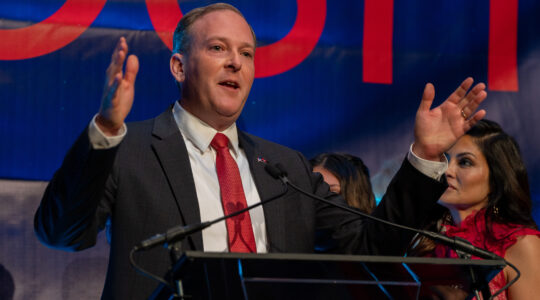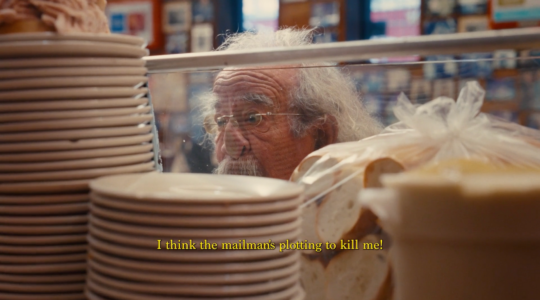God may be invisible but his fingerprints are all over the news, particularly all over the old Berlin Wall. Like the Ninth of Av, which commemorates a chain of sadness, all linked, from the desert Jews to Roman times, the Ninth of November, when the Wall fell, is accumulating a mighty share of coincidence all its own.
Before the Jewish communityís big push to publicize 1988ís 50th anniversary of Kristallnacht, be honest, most folks werenít sure of Kristallnachtís exact date or what happened, let alone the Jewish assassin that gave the Germans their excuse. This year, though, the odd-year 61st anniversary wasnít particularly commemorated by the Jewish community, but the world media was quick to note that itís just too eerie that Germanyís greatest post-war punishment ended precisely on that night that will forever haunt civilized memory.
The Associated Press (Nov. 10) wrote that the collapse of the Wall ìis not a national holiday largely because it coincides with the anniversary of Kristallnacht ó the Night of Broken Glass ó when Nazi storm troopers destroyed Jewish businesses and synagogues 61 years ago, presaging the Holocaust.îThe German chancellor said as much, as did German newspapers.
The New York Times, in its first Wall-falling anniversary story (Nov. 9) did not catch the connection; even its timeline on the Berlin Wall began only with 1945, but a Jerusalem Post (Nov. 12) op-ed by Gerald Steinberg saw Godís fingerprints: ìThe occupation and division of Germany was a disproportionately small punishment for the terrible sins committed during the Nazi era, but it was symbolic. Now, the punishment has ended…îLondonís Daily Telegraph (Nov. 10) detoured from its Wall coverage to not only discuss the magnitude of Kristallnacht but to point out yet another notch on the eerie timeline: Nov. 9 is also the anniversary of Hitlerís 1923 beer hall putsch.
The Internet editions of The Washington Post and The Nation are featuring their feverish, and fascinating, full-length 1938 dispatches on Kristallnacht and its aftermath.Of course, one of the more famous moments in the final days of the Berlin Wall was President Reaganís famous speech on June 12, 1987: ìMr. Gorbachev, tear down this wall!înRigby, The New York Postís editorial cartoonist (Nov. 15), picked up on this to depict Hillary Clinton at the Western Wall, last week, saying: ìMr. Barak, take down this Wall!îIn classic New York City tabloid style, The New York Post has been livid about every faux pas by the first lady on her recent trip. After Mrs. Clinton gave Suha Arafat a kiss following Mrs. Arafatís diatribe against Israel, the Postís front-page screamed: ìShame on Hillary!î (Nov. 12), and ìBarak to Yasser: SHUT HER UP!î ó all in caps, of course.Mrs. Clintonís Jewish problem is getting big play, even beyond the tabloids. Time (Nov. 22) crowned Mrs. Clinton one of its ìlosersî of the week. Overseas, Londonís Daily Telegraph dubbed ìHillary, the First Shiksa,î and after her stumble, The London Times (Nov. 12) headlined: ìHillary fails test on Israeli obstacle course.îBoth the Jerusalem Post (Nov. 15) and Haaretz (Nov. 15) accused Mrs. Arafat of ìanti-Semitic blood libels,î with the J-Post adding: ìThe poison of incitement continues to be spread in mosques, by PA officials, on Palestinian television, and in Palestinian textbooks.îEarlier in November, Israeli newspapers noted that the Palestinian Authority published a textbook comparing similarities ìbetween Nazism, Fascism and Zionism,î and describing the Talmud as a book of hatred toward non-Jews.Sidney Zion, in The Daily News (Nov. 16) writes: ìThe passion is only against Hillary Clinton, whom I feel sorry for,î because Ehud Barak ìwouldnít have noticed Suha Arafatís poisonous slander if the media hadnít covered it as Rudy vs. Hillary.înModerate Arabs are beginning to suggest that even Israelís 1967 borders arenít kosher. The Jordan Times, a moderate English-language daily, ran an op-ed piece (Nov. 11) by Dr. Ahmad Y. Majdoubeh, stating: ìthe core of the conflict between Arabs and Israelis … continues to be, the occupation by Israel of all of Palestine. … There is the question of territories occupied in 1948.î
If so, are secular Israelis in post-1948 territories no less provocative than the settlers recently transferred from the Havat Maon settlement. Timeís daily Web site (Nov. 10) called the Havat Maon settlers, ìzealots.î Yoel Marcus in Haaretz (Nov. 12) called them ìa group of oddballs,î a ìa tiny insane minority.î In that same paper, Zeíev Sternhell said the settlersí land was ìunnecessarily stolen from Palestinian fellahin.îThe Jerusalem Report (Nov. 11), though, quoted one evacuating soldier who found the evacuation painful, saying any Jew would be torn by this kind of encounter.A poll by The Jerusalem Post (Nov. 14) revealed that, of 2,500 respondents, as many as 47 percent opposed the use of force in evacuating Havat Maon.A former Israeli soldier, Kenneth Kaplan, now a staffer at The Boston Globe, wrote (Nov. 14) about being an Israeli soldier who helped evacuated the Yamit settlement in 1982: ìIsraelis braced for the spectacle of their army doing the unthinkable: removing fellow Israelis from homes they had built in good faith to help realize the Zionist dream of a secure homeland.î
The Judean Voice (Nov. 10), representative of the followers of the late Rabbi Meir Kahane, wondered why Kahaneís old plan to transfer Palestinians out of Israeli-held land was ìracist,î but ìtransferring Jews is another story entirely.îThough he hardly envisioned, or would have supported, the post-Oslo peace process, Rabbi Kahane predicted that a transfer would happen, with either Jews or Arabs getting transferred, and so it did. The media ignored the anniversary, but Kahane, stripped of his Knesset seat for such talk, was assassinated on a November afternoon nine years ago; nine years later, almost to the day, it was transfer time for the Jews of Havat Maon.
The New York Jewish Week brings you the stories behind the headlines, keeping you connected to Jewish life in New York. Help sustain the reporting you trust by donating today.




